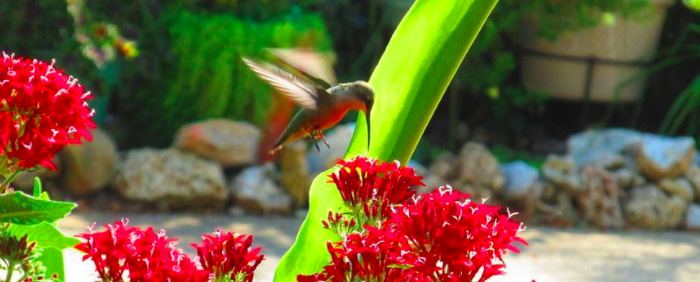
The flowers and plants give color to your garden, but it is the wild life that makes it truly alive. Here’s what you should plant to attract small visitors.
Butterflies love the echinacea nectar while many songbirds feed on their seeds.
Buddleia or butterfly tree (Buddleia)
Buddleia resembles a late-flowering lilac; its branches of fragrant flowers are in shades of red, purple, pink, white or pale yellow. Plant it in a sunny spot and protected from high winds: it will attract countless butterflies as well as hummingbirds.
Serviceberry (Amelanchier)
This shrub giving berries called “small pears” in the popular language, is a native hardy species that attracts many birds and butterflies. It flowers early in the spring, providing nectar for butterflies that emerge from their cocoon early in the season; the flowers are followed by sweet berries, deep blue, whose birds feast.
Viburnum (Viburnum): many species and varieties
There is a viburnum (or two, or three, or six) for each garden. Many of the early flowering hybrids, such as ‘Dawn’ and ‘Juddii’, have very fragrant flowers that attract butterflies. Others, such as pimbina (V. trilobum) or cassinoid viburnum (V. nudum var. Cassinoides), both native plants, produce fruits that remain on the tree for much of the winter, providing food to birds during the toughest season. Plant viburnum in well-drained soil, rich in organic matter and in full sun.
Milkweed (Asclepias)
If you want to attract monarchs to your garden, sow milkweed. The larva (caterpillar stage) of the monarch feeds on the leaves, stems and flowers of this plant, which, by the way, protects it, as well as the adult, birds and other predators, who do not like the taste of this plant. The most popular species among gardeners is tuberous milkweed with red, orange and bright yellow flowers.
Echinacea (Echinacea)
Echinacea, one of the most beautiful perennials, blooms for a long time, resists drought and blooms everywhere, in the sun or half-shade. We find all the colors, from the more classic white and purple, to orange, yellow, gold and green. Butterflies love their nectar while many species of songbirds like the seeds that form after flowering.
Eupatorium
If there is a corner of your garden that is constantly wet, plant this fabulous native perennial because it likes water. In addition, it needs space because it is more than 1.50 meters at maturity. From mid-summer to autumn, the white or pink flower heads attract many nectar-loving butterflies. Leave the flowers in place after flowering: they will form seeds that are appreciated by birds.
Monarde (Monarda)
This plant, closely related to mint and lavender, is appreciated by bees, butterflies and birds, especially hummingbirds, who like the scent it exudes. Give him ample space to multiply and form large beds of red, magenta, purple or pink flowers. Once the flowers are faded, in the middle of autumn, the little songbirds will feast on the seeds that are formed later.
Sunflower (Helianthus)
Today, there are many varieties of dwarf sunflowers that can flourish in small spaces or even pots. Sunflower seeds are rich in oil, making them excellent food for many species of birds.
Lantana (Lantana)
This annual, which is particularly suitable for growing in pots, flower boxes or hanging baskets, is visited by many butterflies. The “flower” is actually composed of tiny flowers that are often in multiple tones. Remove faded flowers to encourage the plant to bloom until the first frost.
Marigold (Calendula)
This year-round without problems often comes back on its own without becoming invasive. Its yellow, creamy, orange or golden daisy-shaped flowers provide an excellent nectar for butterflies, while songbirds like the seeds that form after flowering. Adaptable, the plant grows in the sun or partial shade, and will continue to bloom as long as you remove the withered flowers. At the beginning of the fall, stop taking them off so that, before the first frosts, they have time to form seeds that will feed the birds.